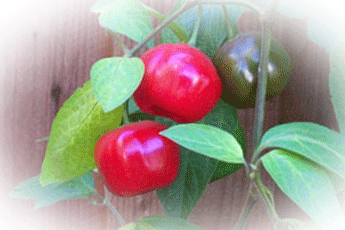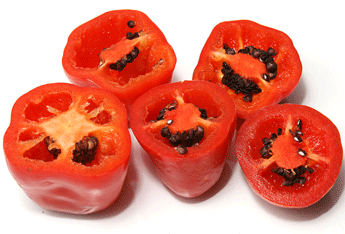One of the oldest known Chillies
Rocoto Chillies are part of the Capsicum pubescens species. They are one of the oldest domesticated Chillies. Rocotos have been cultivated in Bolivia, Ecuador, and Peru for thousands of years. Indeed, traces of their presence were detected in the Guitarrero Cave. This cave is an archaeological site in Peru, where evidence of human presence was found stretching as far back as 1056O BCE. Carbon dating found evidence of Capsicum pubescens dating back to around 8,500 BCE.

The name pubescens refers to the hairiness of the Rocoto Chillies leaves. This trait is found only in the Capsicum pubescens species of Chilli. Rocotos are found in various shapes, sizes and colours. They may resemble apples, pears and tomatoes in shape, and are found in red (Rocoto Roja), Yellow (Canario or Canary Chilli), brown, orange or white.
Rocoto Chillies prefer colder climate weather to grow. Their natural habitat is in the mountains, where temperatures are colder. In ideal conditions, Rocotos grow vines up to 15 feet long. The fruit is small with thick walls. These Chillies pack a hefty Scoville rating of between 30000 and 100000 SHU.
Outside South and Central, America Rocotos are not widely commercially cultivated. The reason for this is they do not like being transported out of their natural environment. It is also highly likely why they were not taken to the West Indies by the Taino people as part of their migration to the Caribbean.
The Taino people were responsible for first cultivating Chillies like Scotch bonnets and Birds-eye (C Frutescens) Chillies when they settled in the Caribbean thousands of years ago. It was there that Christopher Colombus encountered Chillies for the first time.
When a red rocoto (the most prolific cultivar) is cut open, it resembles a tomato with black seeds. This however, is where the similarity ends. Its flavour is described as distinctly fruity with a sweet taste, followed by a healthy dose of pungency
Typical uses for rocotos in cooking include making Rellenos, Ceviche, hot sauces like Huacatay and soups. It isn’t easy to buy them fresh outside their home turf rocoto pastes can be easily found online. They can’t easily be substituted, but if needs be, use Scotch bonnets or Habaneros for pungency alone) or Mexican Manzano Chillies. These look like Rocotos, but are not (although closely related). The Mexican Manzano only has a Scoville rating of 12,000 – 30,000 SHU. They are also of the Capsicum pubescens species
Image credits
The original uploader was JoeCarrasco at English Wikipedia./ CC BY-SA 3.0 / via Wikimedia Commons.
Sebastian Aguilar (DrCooling)/ CC BY-SA 4.0/ via Wikimedia Commons


